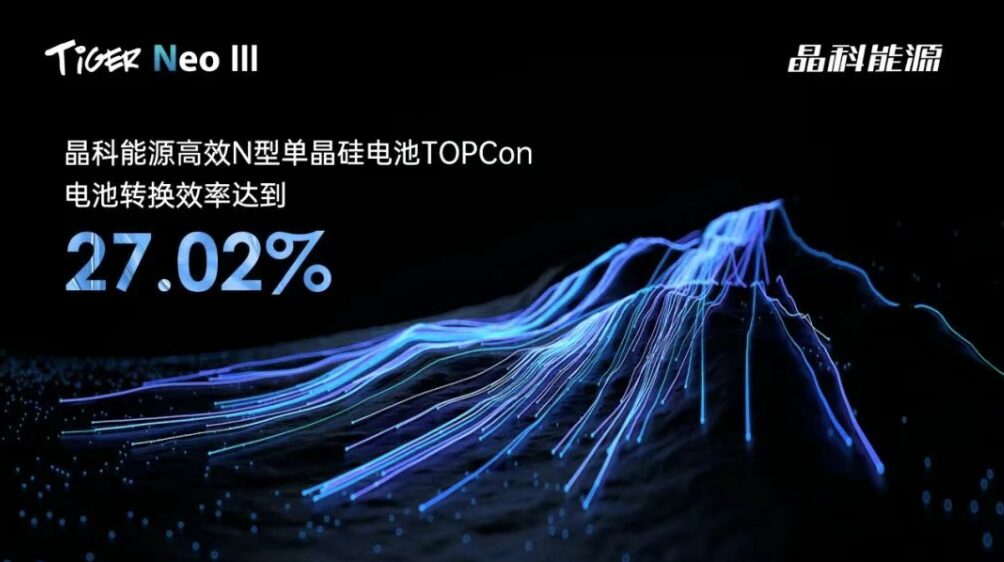JinkoSolar sets new TOPCon conversion efficiency record – PV Tech

JinkoSolar Advances Solar Efficiency with N-type TOPCon Modules
Introduction
JinkoSolar has reached a significant milestone in solar energy efficiency through the independent development of N-type TOPCon modules. These modules have been certified by TÜV SÜD with a maximum conversion efficiency of 25.58%. Furthermore, the 182N-type monocrystalline silicon cell (TOPCon) has achieved a full-area conversion efficiency of 27.02%, as verified by the National Photovoltaic Industry Metrology and Testing Center.
Technological Innovations Driving Efficiency
The efficiency improvements are attributed to several advanced technologies and key innovations, including:
- Metallization laser enhancement
- High-quality emitter passivation
- Local absorption passivation contact on the cell side
- Integrated film graphic technology
- SMBB ultra-multi-main grid technology
- Reflective film technology on the module side
Production Capacity Expansion and Product Performance
JinkoSolar plans to upgrade over 40% of its production capacity within the current year and aims to establish 40-50GW of high-power TOPCon capacity by year-end. The latest high-efficiency TOPCon modules offer:
- Maximum power output of 670W
- Module efficiency up to 24.8%
- Bifaciality of 85%
- Approximately 10% performance premium over traditional TOPCon products
Contribution to Sustainable Development Goals (SDGs)
JinkoSolar’s advancements align closely with several United Nations Sustainable Development Goals, including:
- SDG 7: Affordable and Clean Energy – By enhancing solar module efficiency and expanding production capacity, JinkoSolar promotes access to reliable and sustainable energy sources.
- SDG 9: Industry, Innovation, and Infrastructure – The company’s continuous innovation in N-type TOPCon technology supports resilient infrastructure and fosters sustainable industrialization.
- SDG 12: Responsible Consumption and Production – Upgrading production capacity with high-efficiency modules contributes to more sustainable consumption patterns in the energy sector.
- SDG 13: Climate Action – By improving solar power generation efficiency, JinkoSolar aids in reducing greenhouse gas emissions and combating climate change.
Outlook and Industry Impact
Through ongoing innovation and capacity upgrades, JinkoSolar is positioned to accelerate industry capacity clearance and support “anti-involution” efforts, fostering sustainable long-term development in the solar energy sector. These efforts contribute to the global transition towards clean energy and sustainable industrial growth, reinforcing the company’s commitment to the Sustainable Development Goals.
1. Sustainable Development Goals (SDGs) Addressed or Connected
- SDG 7: Affordable and Clean Energy
- The article discusses advancements in solar energy technology, specifically the development of high-efficiency N-type TOPCon solar modules, which directly relate to increasing access to affordable, reliable, sustainable, and modern energy.
- SDG 9: Industry, Innovation and Infrastructure
- The article highlights technological innovation in solar cell manufacturing and module efficiency improvements, reflecting progress in building resilient infrastructure and fostering innovation.
- SDG 13: Climate Action
- By promoting more efficient solar energy solutions, the article implies contributions to reducing greenhouse gas emissions and combating climate change.
2. Specific Targets Under Those SDGs Identified
- SDG 7 Targets
- Target 7.2: Increase substantially the share of renewable energy in the global energy mix by enhancing solar power technologies.
- Target 7.3: Double the global rate of improvement in energy efficiency, as demonstrated by the increased conversion efficiency of solar modules.
- SDG 9 Targets
- Target 9.5: Enhance scientific research and upgrade technological capabilities of industrial sectors, as shown by the development of advanced metallization laser enhancement and other innovations.
- SDG 13 Targets
- Target 13.2: Integrate climate change measures into policies and strategies, implied by the promotion of sustainable long-term development through solar technology advancements.
3. Indicators Mentioned or Implied to Measure Progress
- SDG 7 Indicators
- Indicator 7.2.1: Renewable energy share in the total final energy consumption, implied by the increased production capacity of high-efficiency solar modules (40-50GW TOPCon capacity).
- Indicator 7.3.1: Energy intensity measured in terms of primary energy and GDP, implied by the improved solar module conversion efficiencies (up to 25.58% for cells and 24.8% for modules).
- SDG 9 Indicators
- Indicator 9.5.1: Research and development expenditure as a proportion of GDP, implied by JinkoSolar’s investment in advanced technologies such as metallization laser enhancement and SMBB ultra-multi-main grid technology.
- Indicator 9.5.2: Number of researchers per million inhabitants, implied by the innovation and certification processes described.
- SDG 13 Indicators
- Indicator 13.2.2: Total greenhouse gas emissions per year, implied by the promotion of higher efficiency solar modules contributing to reduced emissions.
4. Table: SDGs, Targets and Indicators
| SDGs | Targets | Indicators |
|---|---|---|
| SDG 7: Affordable and Clean Energy |
|
|
| SDG 9: Industry, Innovation and Infrastructure |
|
|
| SDG 13: Climate Action |
|
|
Source: pv-tech.org








